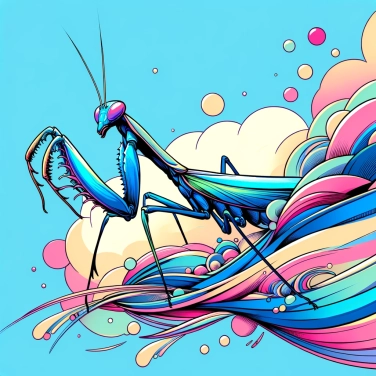The venom of the praying mantis is powerful due to its complex composition containing enzymes and toxins that act on the nervous system and metabolism of their prey, contributing to their paralysis and digestion.

The venom of the praying mantis is a subtle cocktail packed with neurotoxic peptides, short yet highly effective molecules that quickly paralyze its prey. It also contains digestive enzymes that immediately begin to break down the victim's tissues, thus facilitating digestion for the mantis (quick, practical, and efficient!). Among these substances, specific proteins disrupt the nervous system of the prey, causing immediate immobilization and paralyzing shock. The victim cannot fight back; it’s clean and straightforward. This molecular mixture, particularly rich in complex toxins, ensures that the praying mantis can freeze its unfortunate prey in no time.
When the praying mantis injects its venom, it's a quick and effective cocktail: the toxins directly target the nervous system of its prey, paralyzing its muscles in an instant to prevent any escape. In short, the victim insect stands no chance of reacting or fleeing. The venom contains powerful digestive enzymes, facilitating the rapid breakdown of internal tissues: the mantis can then calmly suck the nutritious slurry from its immobilized prey. Its chemical formula is ultra-effective in quickly neutralizing insects, even the toughest ones. This nearly instantaneous paralytic effect ensures the praying mantis a peaceful hunt without engaging in a prolonged struggle.
The powerful venom of the praying mantis did not arrive there by chance. Over time, these insects developed this formidable weapon through particularly ruthless natural selection. Specifically, those that produced the most effective toxins to immobilize their prey inevitably had more success in nourishing their offspring and surviving. In the case of the praying mantis, venom has become an essential asset, allowing it to attack a wide range of prey and even defend itself against certain tough predators. Today, this chemical cocktail is perfectly suited to their hunting style: their venom acts quickly, paralyzes almost immediately, and thus avoids any prolonged struggle that could cost them a lot of energy. This adaptation over generations has resulted in a venom of formidable effectiveness, optimized to the maximum for survival in their natural environment.
The venom of the praying mantis may seem impressive, but compared to other venomous arthropods like spiders or scorpions, it remains relatively less dangerous to humans. For example, the venom of the Leiurus quinquestriatus scorpion is much more powerful and potentially deadly, while that of the mantis mainly targets its usual prey (small insects, crickets, flies...) to immobilize them quickly. Unlike red ants, which use their venom primarily to deter predators, the mantis's venom is specifically adapted for hunting. In terms of sheer potency, well-known venomous species such as the black widow or the banana spider are clearly more intense and pose a real risk to humans. The strength of the mantis's venom lies mainly in its precise cocktail of paralyzing toxins that affects its usual victims.
The venom of the praying mantis is of great interest to researchers because it contains toxins with anti-inflammatory and even antimicrobial properties. By isolating certain molecules from the venom, scientists hope to develop new drugs against antibiotic-resistant infectious diseases. Research is also focusing on the ability of venom compounds to specifically target cancer cells without affecting healthy cells. If we can understand how these molecules work, it could lead to highly effective, almost personalized targeted therapies. In short, the praying mantis holds promising keys in its venom for the medicine of tomorrow.
Scientists are carefully studying the toxins found in arthropod venoms; indeed, some compounds could be useful in developing powerful natural analgesics that are more effective and have fewer significant side effects.
Despite its formidable appearance, the praying mantis is harmless to humans, its venom being specifically adapted for small insectivorous prey.
Contrary to a common belief, it is primarily the powerful jaws of the praying mantis that immobilize its prey, with its venom usually serving only to aid in immobilization and predigestion.
The venom of certain arthropod insects is currently generating significant scientific interest for the development of treatments for neurological diseases due to their ability to precisely target nerve channels.
Currently, studies on the potential therapeutic applications of mantis venom are still limited. However, the unique molecular properties of the venom intrigue researchers and could provide interesting avenues for future treatments.
The praying mantis has several natural predators, including birds, bats, lizards, and even larger arthropods. Its effective camouflage and aggressive behavior are its main weapons against these predators.
In case of a pinch or a bite from a praying mantis, wash the affected area thoroughly with soap and water to prevent infection. You can apply cold to soothe pain or temporary irritation. If an unusual reaction occurs, seek medical attention promptly.
No, the sting of a praying mantis is generally not dangerous to humans. It does not inject venom in sufficient quantities to cause severe reactions, but it can still result in slight pain or temporary irritation.
The majority of mantid species possess venom glands, but the potency and exact effects of this venom can vary considerably from one species to another. However, they primarily use their venom to quickly immobilize their prey.

No one has answered this quiz yet, be the first!' :-)
Question 1/5